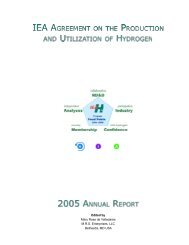Technology Status of Hydrogen Road Vehicles
Technology Status of Hydrogen Road Vehicles
Technology Status of Hydrogen Road Vehicles
Create successful ePaper yourself
Turn your PDF publications into a flip-book with our unique Google optimized e-Paper software.
Pizak, V. et al., “Investigations <strong>of</strong> the Kinetics and Catalysis <strong>of</strong> the Iron/Steam-Magnetitie/<strong>Hydrogen</strong><br />
System in low temperature regime with regard <strong>of</strong> its use to produce and store hydrogen,” Center for<br />
Solar Energy and <strong>Hydrogen</strong> Research, Ulm, Germany, pp. 1175-1183.<br />
This poster presentation examines an old method for H 2 production—reacting steam with red-hot sponge ironfor<br />
suitability for on-board use, especially using sponge iron from the direct reduction <strong>of</strong> iron process.<br />
After some fundamental work on the kinetics <strong>of</strong> the reaction, the main result seems to be that a very large and<br />
stabilized surface area <strong>of</strong> sponge iron is needed at temperatures lower than 300ºC. The method is, however,<br />
practicable for hydrogen generation from sponge iron (which in turn could have been produced by H 2<br />
reduction <strong>of</strong> the ore), but best introduced in heavy transport systems such as locomotives or submarines.<br />
TOPIC 4: Technologies <strong>of</strong> <strong>Hydrogen</strong> Utilization<br />
Scott, D.S., et al., “Harvesting Thermomechanical Energy from LH 2: Transportation Applications,”<br />
University <strong>of</strong> Victoria, British Columbia, Canada, pp. 1449-1452.<br />
The authors point out that the 10% thermomechanical energy in LH 2 should not be wasted, concentrating only<br />
on its 90% chemical energy. By comparison, gasoline has 0% thermomechanical energy and steam has 100%.<br />
An example <strong>of</strong> how to harness this 10% in LH 2 would be to use it as the heat sink in a cryogenic heat engine.<br />
There are other possibilities that the designer should stay alert to.<br />
Peschka, W., “<strong>Hydrogen</strong> the Future Cry<strong>of</strong>uel Fuel in Internal Combustion Engines,” German Aerospace<br />
Research Establishment, Stuttgart, Germany, pp. 1453-1481.<br />
This comprehensive review <strong>of</strong> the successive improvements in ICE performance with LH 2 fuel takes as a<br />
starting point the order-<strong>of</strong>-magnitude advantage that the ICE has over the FC for specific power (kW/kg), with<br />
today’s technology or even with advanced technology.<br />
After reviewing the problems with external mixture formation, and internal mixture formation with early-start<br />
injection, he concludes that latter not much better than former, and that late-start injection (~ 5 o BTDC),<br />
although it resolves most problems, has only about 5 ms at 5,000 rpm for injection, mixing, ignition, and<br />
combustion. This means that 15–20 Mpa LH 2 injectors are needed to inject much increased gaseous fuel<br />
volumes (in small and medium vehicles, cryogenic H 2 is always gas in combustion chamber) in the 2-3 ms<br />
available.<br />
He therefore feels that the optimum solution is a hybrid one: early-start injection <strong>of</strong> 0.4-0.5 Mpa LH 2 into a<br />
lean mix, ignition at ~5 o BTDC with no pre-ignition or NO x; then cryogenic H 2 injected at 20 MPa into flame<br />
front at ~5 o BTDC giving turbulence and mixing. This hybrid allows very low NO x, and gives similar engine<br />
performance (power and torque) as conventional fuels.<br />
He claims that fuel conditioning systems for LH 2/ICE is much cheaper than low-cost FC.<br />
Naber, J.D.; D.L. Siebers, “<strong>Hydrogen</strong> Combustion under Diesel Engine Conditions,” Sandia National<br />
Laboratories, California, USA, pp. 1503-1512.<br />
There are potential advantages in efficiency, power density, and safety in hydrogen engines running under<br />
diesel direct-injection conditions, compared to premixed, spark-ignited conditions.<br />
60













